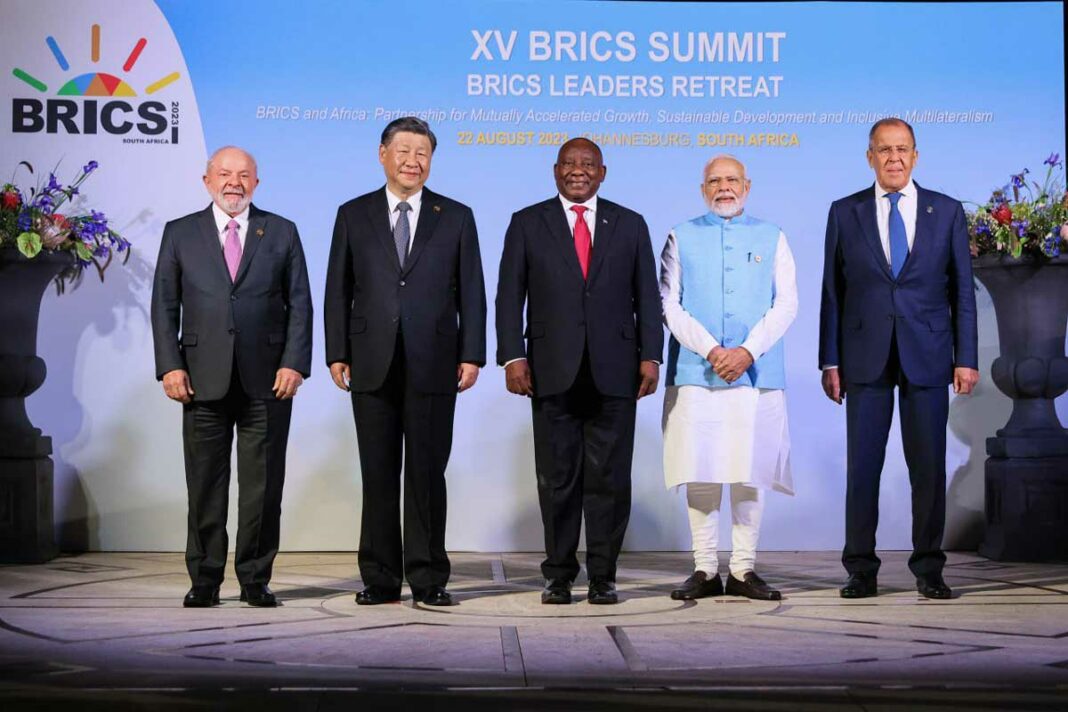Media reports of Prime Minister Narendra Modi and Chinese President Xi Jinping meeting on the sidelines of the BRICS summit at Johannesburg talk of both leaders “agreeing to intensify efforts for expeditious disengagement and de-escalation on the Line of Actual Control (LAC) in eastern Ladakh. This is not very different from the 19 rounds of Corps Commander-level and other military-to-military talks, which cite such directions from the leadership of both countries.
The message posted by the Chinese Embassy at New Delhi reads: “On August 23rd, President Xi Jinping and Indian Prime Minister Narendra Modi had a candid & in-depth exchange of views on current China-India relations & other questions of shared interest on the sidelines of the BRICS Summit.
Responding to a question about the Modi-Xi meeting in a press conference in Beijing on August 25, the spokesperson of China’s Ministry of Foreign Affairs said: President Xi Jinping talked with Indian Prime Minister Narendra Modi on the sidelines of the BRIC Summit at the latter’s request on August 23, 2023. The two leaders had a candid and in-depth exchange of views on current China-India relations and other questions of shared interest. President Xi stressed that improving China-India relations serves the common interests of both countries and peoples, and is also conducive to peace, stability and development of the world and the region. The two sides should bear in mind the overall interests of their bilateral relations and handle properly the border issue so as to safeguard peace and tranquility in the border region.
India has refuted the Chinese claim that the meeting was requested by India; saying this was a “pending request” by China and that the meeting was “informal”. If the request was indeed by China, then shifting the onus on to India is clearly a diplomatic snub, which China is quite capable of. But the noteworthy issue is that none of the above Chinese statements mention “disengagement” and “de-escalation”.
The other noteworthy issue is that while Defence Minister Rajnath Singh has been harping that “not even one inch of territory has been lost” in eastern Ladakh, India is now calling for China to push back from Y-Junction in Depsang which is 20 km inside our territory. Our media further says that the “spotlight is now on the exact contours of plans being drawn up by military commanders on the ground to pull back troops”. The Major General-level talks have since concluded.
The ball seems to have been left squarely in the military’s court. In this context, a distinguished veteran-scholar writes, “These military-to-military talks (Corps Commander or Major-General-level) are the outcome of sheer dereliction of duty by the MEA, bureaucrats and the NSA, whose job is to engage in talks, not the military.” Possibly, these individuals have been rebuffed so hard by their Chinese counterparts that they have taken recourse to sit on the fence and keep feeding indigenous media what they never had the guts to tell the Chinese.
The bane of the issue is the government’s pusillanimous attitude towards China. In November 2019, Tapir Gao, BJP MP from Arunachal Pradesh, told Parliament that PLA has intruded 50-60 km inside Arunachal Pradesh and warned of a Doklam-like situation. There was no government response. China’s construction of dual-use military villages inside Arunachal Pradesh also evoked a vague response from MEA.
Government remains in denial of losing control of vast tracts of territory in Ladakh in 2020, including traditional grazing grounds, which forced migration of locals. On August 23, 2023, former Rajya Sabha MP and BJP member Subramanian Swamy said in a video interview that India has lost 4,600 sq km territory in Ladakh and the PLA is entrenched well inside our 1996 claim line. But our politicians and diplomats continue to cover up the loss and the NSA maintains silence.
Government policy towards China appears to be of appeasement although the impression created in media is that China is being shown its place. China is making more money through bilateral trade with India than was the case before the 2020 Chinese aggression in Ladakh. There are occasional reports of banning some Chinese products and rejecting an odd Chinese bid. But Chinese banks are functioning merrily in India. China enjoys multiple indirect avenues to invest in India and Indian investors are pouring money into China-focused mutual funds.
China’s statement of Xi having stressed “we must safeguard peace jointly’ In his conversation with Modi and that “improving China-India relations serves common interests and is conducive to peace and stability of the region and the world” is being interpreted by some as possible pull back by China in Ladakh before Xi comes for the G20 Summit here next month. Some even speculate that this is because of pressure on Xi because of tension with the US over Taiwan.
But this may be wishful thinking. Can we discard the possibility that China is signaling a status quo through these statements, especially when it holds all the aces – don’t disturb the border and continue with where we are today? Hasn’t China been refusing any pullback in the last few rounds of talks? Isn’t this why China demanded a 15-20 km buffer zone in Depsang in one of the recent rounds of talks? Isn’t this why China has never mentioned “patrolling” in buffer zones, which only our spin doctors did?
Our troops can no longer access 26 of their 65 patrolling points between Karakoram Pass and Chumar in eastern Ladakh and all buffer zones are in Indian Territory. What modalities is the military expected to work out with the PLA having consolidated their new positions occupied in 2020? Do we expect them to dismantle their post at Y-Junction 20-km inside Depsang, and if so, in exchange of what? Do we expect them, for example, to allow patrolling up to Finger 8 (as was the case earlier) along the north bank of Pangong Tso where they have deployed tanks now?
It is, therefore, for the government (not the military) to work out what modalities can be fed to our public – new buffer zone (s), patrolling up to whatever point and the like. The military anyway has no option but to abide by whatever charade the MEA wants to play and Beijing would unlikely make any statement as long as the status quo is accepted by India.
Finally, any change in China’s stance towards India would be visible if Xi attends the G20 Summit at New Delhi in-person next month and both leaders have a proper bilateral meeting.
The author is an Indian Army veteran. Views expressed are personal.
~ News4masses is now also on Google news
~ If you want to contribute an article / story, please get in touch at: news4masses[at]gmail[dot]com



















